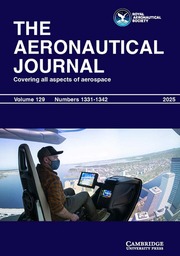Article contents
Drag reduction in a rectangular duct usingriblets
Published online by Cambridge University Press: 04 July 2016
Abstract
An experimental investigation has been made into theeffects of riblets on the drag in a rectangular ductof aspect ratio 10. It has been found that a maximumdrag reduction of approximately 10% occurs in fullydeveloped turbulent flow. This figure is larger thanthe 6–8% drag reduction usually found for externalflow. The maximum drag reduction occurred when theheight of the riblets was between 7 and 13 wallunits. Analysis of the developing region of the flowhas shown a maximum drag reduction of approximately8% at a wall unit value of 13, consistent withresults in external flows. The effects of riblets ontransition has also been investigated. It was foundthat riblets delayed transition by 2–4% in criticalRe as measured by peak flatness, and caused someextension in the length of the transition process,so that the completion of transition was delayed bybetween 4–8%, with the stronger effect at the lowerReynolds numbers.
Information
- Type
- Research Article
- Information
- Copyright
- Copyright © Royal Aeronautical Society 1995
References
- 6
- Cited by

